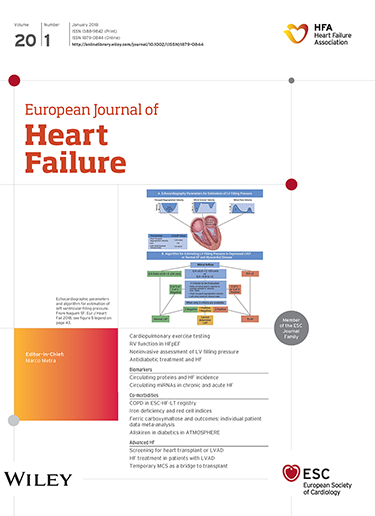心力衰竭临床实践指南在中低收入国家的适用性
IF 16.9
1区 医学
Q1 CARDIAC & CARDIOVASCULAR SYSTEMS
引用次数: 0
摘要
目的临床实践指南通常由高收入国家(HIC)的专业协会编写,对其他环境中的实施障碍预期有限。我们以心力衰竭(HF)指南为范例,通过调查了解临床医生实施HF指南的能力以及他们对当前HF指南在中低收入国家(LMIC)适用性的看法,从而研究这一问题。方法与结果 2023年10月5日至11月27日,我们通过电子邮件对转化医学研究院数据库中治疗HF患者的医生进行了在线调查,询问了参与者的人口统计学信息、经验以及对HF指南与其实践相关的看法。在 2622 名参与调查的临床医生中,有 1592 人完成了部分调查,另有 1030 人完成了全部调查。参与者来自 138 个国家,其中 668 人在高收入国家和地区执业,1954 人在低收入国家和地区执业。与来自高收入国家和地区的参与者相比,来自低收入国家和地区的参与者认为高血压指南在他们国家的适用性较低(p = 0.0002)。在所有回复者中,75.3% 的人表示心房颤动指南在某种程度上或大部分情况下适用于高收入国家。来自低收入和中等收入国家而非高收入国家的受访者表示,指南实施的最大障碍是指南适用于高收入国家(51.3% vs. 43.1%;p = 0.0387)。来自低收入和中等收入国家的受访者表示,在大多数情况下,用于护理病人的资源在某种程度上或大部分情况下受到限制的比例明显高于高收入国家(41.6% vs. 32.5%,p = 0.0068)。来自低收入和中等收入国家的临床医生认为,缺乏对当地资源限制的考虑是指南实施的最大障碍。有关心房颤动指南的研究结果还可能对其他指南和由此产生的患者预后产生影响。本文章由计算机程序翻译,如有差异,请以英文原文为准。
Applicability of heart failure clinical practice guidelines in low‐ and middle‐income countries
AimsClinical practice guidelines are commonly written by professional societies in high‐income countries (HIC) with limited anticipation of implementation obstacles in other environments. We used heart failure (HF) guidelines as a paradigm to examine this concern, by conducting a survey to understand clinicians' ability to implement HF guidelines and their perceptions of the current HF guideline applicability in low‐ and middle‐income countries (LMIC).Methods and resultsAn online survey of physicians in the database of the Translational Medicine Academy who treat HF patients was offered by email from 5 October to 27 November 2023, inquiring of participants' demographic information, experience, and views of HF guidelines as related to their practice. Of 2622 participating clinicians, 1592 partially completed, and an additional 1030 fully completed the survey. Participants were from 138 countries; 668 practiced in HIC, and 1954 in LMIC. Those from LMIC regarded HF guidelines to be less applicable in their country than did those from HIC (p = 0.0002). Of all those responding, 75.3% indicated that it was somewhat or mostly true that the HF guidelines were mostly applicable to HIC. Those from LMIC, but not HIC indicated that the greatest implementation obstacle was that the guidelines were for HIC (51.3% vs. 43.1%; p = 0.0387). A significantly higher proportion of respondents from LMIC indicated that resources for caring for their patients were somewhat or mostly limiting in most cases, than did those in HIC (41.6% vs. 32.5%, p = 0.0068).ConclusionThis survey examined the widely‐held thought that HF guidelines are broadly applicable to all regions of the world, concluding that such a perception is incorrect. Clinicians from LMIC view the absence of consideration of local resource limitations as the greatest obstacle for guideline implementation. The results regarding HF guidelines likely also have implications for other guidelines and resultant patient outcomes.
求助全文
通过发布文献求助,成功后即可免费获取论文全文。
去求助
来源期刊

European Journal of Heart Failure
医学-心血管系统
CiteScore
27.30
自引率
11.50%
发文量
365
审稿时长
1 months
期刊介绍:
European Journal of Heart Failure is an international journal dedicated to advancing knowledge in the field of heart failure management. The journal publishes reviews and editorials aimed at improving understanding, prevention, investigation, and treatment of heart failure. It covers various disciplines such as molecular and cellular biology, pathology, physiology, electrophysiology, pharmacology, clinical sciences, social sciences, and population sciences. The journal welcomes submissions of manuscripts on basic, clinical, and population sciences, as well as original contributions on nursing, care of the elderly, primary care, health economics, and other related specialist fields. It is published monthly and has a readership that includes cardiologists, emergency room physicians, intensivists, internists, general physicians, cardiac nurses, diabetologists, epidemiologists, basic scientists focusing on cardiovascular research, and those working in rehabilitation. The journal is abstracted and indexed in various databases such as Academic Search, Embase, MEDLINE/PubMed, and Science Citation Index.
 求助内容:
求助内容: 应助结果提醒方式:
应助结果提醒方式:


